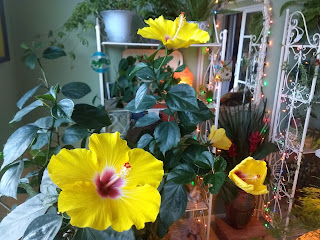It's the last Saturday of the month and that means my essay on some rare and endangered plant has to be posted to the Native Plants of NM Facebook group. Fortunately, I'm ahead of the game and I've got Viola calcicola written up and scheduled to auomatically appear this Saturday morning.
---------------
Viola calcicola R.A.
McCauley & H.E. Ballard
This month I'm looking to describe a rare plant that might
actually be in bloom right now. Depending on how warm the spring
turns out, this little (and I do mean little) jewel of a violet could
be in flower right now down in the Guadalupe Mountains.
The species was described just in 2013 by Ross A. Mccauley of Fort
Lewis College and Harvey E. Ballard, Jr. of Ohio University. Our
species of interest today is removed by many hundreds of kilometers
from any likely relatives and is the second endemic violet found in
the Guadalupe Mountain region.
Description (as always, from NM
Rare Plants): Acaulescent (having no obvious
stem) perennial herb from a short (ca 2.5 cm, 1 inch) vertical
rhizome bearing stout fibrous roots; leaves all unlobed or rarely
shallowly trilobate; petioles of longest leaves 3-7 cm; leaf blades
cordate, triangular-cordate to deltoid with rounded-serrate margins,
glabrous; chasmogamous flowers solitary on peduncles generally borne
at or slightly above the leaf blades; sepals variable, ovate to
lanceolate, the lowest 3-5 mm long and 1-2 mm wide; corolla 0.8-1.5
cm long; petals on different plants varying from nearly white
(faintly flushed with violet) to medium purple, lateral petals having
few inconspicuous purple veins, spurred petal with prominent and
extensive nectar guides, lateral and upper petals narrowly obovate,
spurred petal obovate with long-tapering base, 10-13(-15) mm long
including spur, 3-5 mm wide, broadly obtuse to rounded at apex;
spurred and upper petals glabrous within, lower lateral petal
sparsely bearded with few to several clavate or knob-shaped hairs;
cleistogamous (non-opening, self-pollinating) flower buds to 3 mm
long on peduncles shorter than the leaves; fruit a glabrous capsule.
Flowering April to May.
There are no other Viola species with purple flowers in the
Guadalupe Mountains. The adjacent Sacramento Mountains have Viola
nephrophylla, which has purple petals, but is quickly
distinguished by some pubescence on its petal spur.
Violets are the largest genus of cleistogamous plants, forming
flower buds that don't open and self-pollinate. Self-pollination
works well when you can't find a partner for sexual reproduction, but
it limits variability, which can lead to evolutionary dead ends.
Fortunately, our violet also produces chasmogamous (open pollinated)
flowers. Because these plants live in adverse habitats, cleistogamy
may be a way of guaranteeing seed set even if the population size is
small and there are no conspecifics nearby.
Distribution: Eddy and Otero counties in NM and Culberson County
across the border in TX. The plant favors escarpments and deep
canyons on the eastern slope of the Guadalupe Mountains where it
finds suitable cracks in Permian age limestone in riparian woodland
and montane scrub up to pinyon-juniper woodland, usually on
north-facing cliff faces or near spring seeps. 1,525 m (5,000 ft) to
2,135 m (7,000 ft).
Viola calcicola is one of a suite of chasmophilous (
thriving or dwelling in rock crevices, chinks, fissures, crannies,
and chasms) plants endemic to the limestone cliffs of the Guadalupe
Mountains and adjacent sky-island ranges. In New Mexico it is
sympatric with the rare Aquilegia chaplinei, Hedeoma
apiculata, Perityle quinqueflora, Polyglala rimulicola,
Salvia summa, Nama xylopodum, Chaetopappa hersheyi,
and Valeriana texana. Do you notice a pattern?


















































